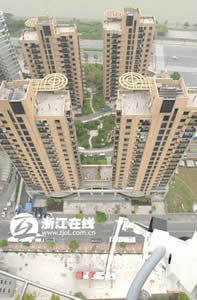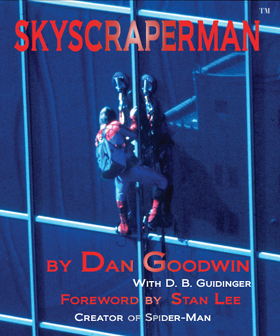
Skyscraper Rescue Equipment
Unique systems from proprietors that have the
potential to save precious life.
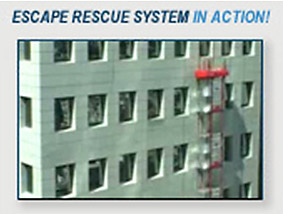
Rescue Elevators
Escape Rescue Systems, an Israel-based company, has developed a multilevel elevator that will descend from the roof of the building. Upon deployment, the cabins array is lowered to the ground. It then unfolds, enabling emergency responders to board the cabins. It travels upwards until it stops opposite five elevated floors simultaneously; enabling 150 occupants to enter through specially configured exit windows. The array is then lowered to the ground and tenants exit as it refolds. The system repeats this cycle, transporting responders up and into the building and evacuating tenants as required.
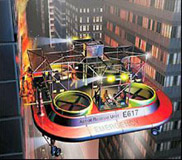
AERIAL RESCUE PLATFORM:
The Eagle vertical takeoff and landing
aerial rescue platform, by DM AeroSafe of Ashdod, Israel, is designed
pull alongside a building to rescue as many as 10 people at a time.
The pilot can change the pitch of the engines to drive the craft forward
or negotiate a docking for rescue at high altitudes. The evacuees
would be harnessed into chairs and protected from falling debris by
a Kevlar cage. Four ducted fans arranged on the corners elevate the
Eagle alongside a building and can operate for five hours without
refueling.
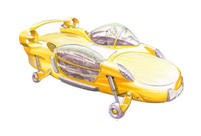
AERIAL RESCUE CAR
Urban Aeronautics, a company based out of Israel, claims the X-Hawk flying car will be ready for production by 2010. X-Hawk is a ‘rotorless’ Vertical-Take-Off and Landing (VTOL) aircraft. To be more precise, it is an aircraft that has the VTOL capability of a helicopter, but without the exposed rotors that make it dangerous or impossible for helicopters to maneuver in complex urban and natural environments. It does, however, have its limitations; only four or five people can be rescued at a time.
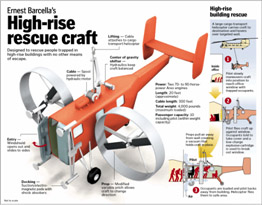
HIGH-RISE RESCUE CRAFT
Ernest Barcella, a Bakersfield aircraft mechanic/inventor, has designed a model for a rescue vehicle. According to the inventor, the rescue craft has all the capabilities of a helicopter, but without the lift -- and without the huge rotors spinning overhead. According to Barcella's vision, his semi-copter would hang from a cable below an actual helicopter hovering above a burning or damaged building. With two propellers but no overhead rotor, the front of the rescue pod could power itself flush with the vertical wall of a high-rise. The flat nose would then open and allow those in danger to exit from a window into the rescue vehicle. The vehicle could also be used to deploy a police department's SWAT team or a military anti-terrorism squad into a building being held by criminals or terrorists.
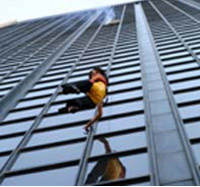
SPIDER RESCUE SYTEMS
An Israeli company, known as Moseroth Technologies, has developed a smart rescue system that can be controlled and operated by an occupant trapped inside a burning skyscraper. The compact device, made of fire safe steel, can lower people to the ground via a harness and steel cable. In only one and a half minutes, two people can be lowered from a 15th story building. Unfortunately, however, the device is limited to a maximum height of 50 floors.
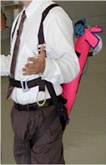
ESCAPE CHUTE
For those who are willing to take their
lives into their own hands, there is the parachute. Precision Aerodynamics,
from Dunlap, Tenn. has developed  the
EscapeChute. The custom parachute can accommodate jumpers from heights
120 feet and above. It is activated by an automatic-opening static
line attached inside a window or to a roof. Each parachute comes made
to order, packed in a small nylon bag and with an instructional video.
The maximum weight limit is 220 pounds and the chute is suitable for
only one user.
the
EscapeChute. The custom parachute can accommodate jumpers from heights
120 feet and above. It is activated by an automatic-opening static
line attached inside a window or to a roof. Each parachute comes made
to order, packed in a small nylon bag and with an instructional video.
The maximum weight limit is 220 pounds and the chute is suitable for
only one user.
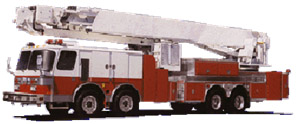
WORLD’S TALLEST AERIAL TRUCK
The Bronto Skylift 235, can lift 1000 pounds and reach a height of 235 feet, or 23 floors. In comparison, the national average for an aerial truck in United States is a meager 7 floors.
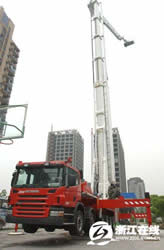
100 METER TALL FIRE TRUCK
The BFirefighting authorities in Hangzhou, capital of eastern China's Zhejiang Province, have imported a fire engine from Finland capable of putting out fires in high-rises up to 100 meters tall.
